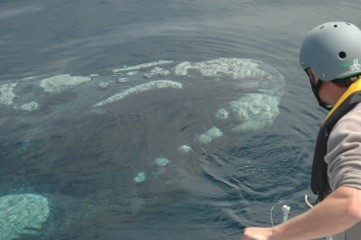Satellite tagging to help solve the puzzle of
Southern Right Whale die-off in Patagonia
The latest satellite tagging technology has been deployed by scientists investigating seasonal whale calf deaths in Peninsula Valdes, Argentina. It’s hoped the tracking devices will provide more pieces of a ten-year puzzle that has involved biologists, veterinarians, oceanographers and specialists in stress, krill and climate change.
672 Southern Right whales have died at Peninsula Valdes in the last ten years, the vast majority young calves. A number of explanations have been proposed: nutritional stress due to krill depletion, bacterial biotoxins in nursery waters, infectious disease and gull harassment. So far there has not been enough evidence to confirm that one or a combination of these factors is to blame. An IWC Conservation Management Plan is in place, and organisations from around the world are working with the Government of Argentina to understand the reasons for the die-off and explore the scope for solutions. The tagging programme is their latest tool.
Transmitters were successfully attached to five whales: three young, solitary males, nicknamed Papillon, Barefluke and Blubber, and two adult females with calves. The adult females are known as Helena and Buenda Onda. Assuming the tags stay attached to the whales, they will transmit geographical positions several times a day. Two of the tags are also equipped to monitor dive profiles and the temperature of the whales’ preferred habitats. All this information will be used to understand the location and condition of feeding grounds as well as the migratory routes taken to reach them.
It is two weeks since the tags were attached and transmissions began. The three young males have left the nursery waters of Peninsula Valdes. They have covered the wide ocean shelf, reached the shelf break over 200 miles offshore, and are now heading in a south-easterly direction, crossing deep, open-ocean water towards Antarctica. The adult females remain close to the Argentinian coast, waiting until their calves are strong enough to complete the long migration.
So far the project is a success, but the clock is ticking. The tags will not stay attached to the whales for more than a month or two. It’s hoped that by then, all five tagged whales and the two calves will have safely reached their summer feeding grounds, and scientists will have obtained more pieces of this complex puzzle.
The organisations involved in the tagging programme are The Wildlife Conservation Society, the Aqualie Institute (Brazil) and the National Oceanic and Atmospheric Administration (NOAA, USA) in collaboration with Fundacion Patagonia Natural (Argentina), Instituto de Conservacion de Ballenas (Argentina), Ocean Alliance (USA), and The University of California, Davis (USA). These participating organisations are committed to continuing this research over the coming years if funding can be found.
To read more about the the tagging of these five whales, and learn about the work of the Wildlife Conservation Society please click here.
For more information about the Southern Right Whale die-off at Peninsula Valdes click here.
For more information about the IWC Conservation Management Plan for the western South Atlantic population of Southern Right Whales click here.

